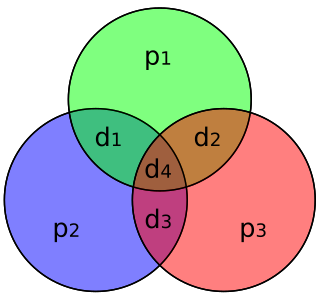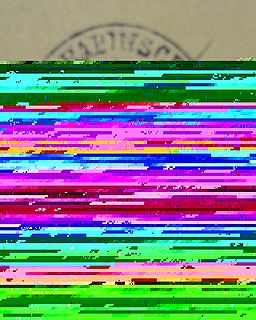In information theory and coding theory with applications in computer science and telecommunication, error detection and correction or error control are techniques that enable reliable delivery of digital data over unreliable communication channels. Many communication channels are subject to channel noise, and thus errors may be introduced during transmission from the source to a receiver. Error detection techniques allow detecting such errors, while error correction enables reconstruction of the original data in many cases.
A cyclic redundancy check (CRC) is an error-detecting code commonly used in digital networks and storage devices to detect accidental changes to raw data. Blocks of data entering these systems get a short check value attached, based on the remainder of a polynomial division of their contents. On retrieval, the calculation is repeated and, in the event the check values do not match, corrective action can be taken against data corruption. CRCs can be used for error correction.

In telecommunication, Hamming codes are a family of linear error-correcting codes. Hamming codes can detect up to two-bit errors or correct one-bit errors without detection of uncorrected errors. By contrast, the simple parity code cannot correct errors, and can detect only an odd number of bits in error. Hamming codes are perfect codes, that is, they achieve the highest possible rate for codes with their block length and minimum distance of three. Richard W. Hamming invented Hamming codes in 1950 as a way of automatically correcting errors introduced by punched card readers. In his original paper, Hamming elaborated his general idea, but specifically focused on the Hamming(7,4) code which adds three parity bits to four bits of data.
In telecommunication, a longitudinal redundancy check (LRC), or horizontal redundancy check, is a form of redundancy check that is applied independently to each of a parallel group of bit streams. The data must be divided into transmission blocks, to which the additional check data is added.
A parity bit, or check bit, is a bit added to a string of binary code to ensure that the total number of 1-bits in the string is even or odd. Parity bits are used as the simplest form of error detecting code.
A disk array controller is a device which manages the physical disk drives and presents them to the computer as logical units. It almost always implements hardware RAID, thus it is sometimes referred to as RAID controller. It also often provides additional disk cache.
In cryptography, Madryga is a block cipher published in 1984 by W. E. Madryga. It was designed to be easy and efficient for implementation in software. Serious weaknesses have since been found in the algorithm, but it was one of the first encryption algorithms to make use of data-dependent rotations, later used in other ciphers, such as RC5 and RC6.

Data corruption refers to errors in computer data that occur during writing, reading, storage, transmission, or processing, which introduce unintended changes to the original data. Computer, transmission, and storage systems use a number of measures to provide end-to-end data integrity, or lack of errors.
A bit array is an array data structure that compactly stores bits. It can be used to implement a simple set data structure. A bit array is effective at exploiting bit-level parallelism in hardware to perform operations quickly. A typical bit array stores kw bits, where w is the number of bits in the unit of storage, such as a byte or word, and k is some nonnegative integer. If w does not divide the number of bits to be stored, some space is wasted due to internal fragmentation.
A NetApp FAS is a computer storage product by NetApp running ONTAP operation system; terms ONTAP, AFF, FAS often used as synonyms, also filer is a synonyms though it is not an official name. There are two types of FAS systems, Hybrid and All-Flash:
- NetApp proprietary custom-build hardware appliances with HDD or SSD drives called hybrid Fabric-Attached Storage
- NetApp proprietary custom-build hardware appliances with only SSD drives and optimized ONTAP for low latency called ALL-Flash FAS.

XOR gate is a digital logic gate that gives a true output when the number of true inputs is odd. An XOR gate implements an exclusive or; that is, a true output results if one, and only one, of the inputs to the gate is true. If both inputs are false (0/LOW) or both are true, a false output results. XOR represents the inequality function, i.e., the output is true if the inputs are not alike otherwise the output is false. A way to remember XOR is "one or the other but not both".
Data scrubbing is an error correction technique that uses a background task to periodically inspect main memory or storage for errors, then correct detected errors using redundant data in the form of different checksums or copies of data. Data scrubbing reduces the likelihood that single correctable errors will accumulate, leading to reduced risks of uncorrectable errors.
In computer storage, the standard RAID levels comprise a basic set of RAID configurations that employ the techniques of striping, mirroring, or parity to create large reliable data stores from multiple general-purpose computer hard disk drives (HDDs). The most common types are RAID 0 (striping), RAID 1 and its variants (mirroring), RAID 5, and RAID 6. RAID levels and their associated data formats are standardized by the Storage Networking Industry Association (SNIA) in the Common RAID Disk Drive Format (DDF) standard.
Nested RAID levels, also known as hybrid RAID, combine two or more of the standard RAID levels to gain performance, additional redundancy or both, as a result of combining properties of different standard RAID layouts.
Although all RAID implementations differ from the specification to some extent, some companies and open-source projects have developed non-standard RAID implementations that differ substantially from the standard. Additionally, there are non-RAID drive architectures, providing configurations of multiple hard drives not referred to by RAID acronyms.
mdadm is a Linux utility used to manage and monitor software RAID devices. It is used in modern GNU/Linux distributions in place of older software RAID utilities such as raidtools2 or raidtools.
A RAID processing unit (RPU) is an integrated circuit that performs specialized calculations in a RAID host adapter.




